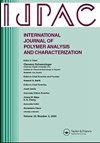蔗渣/罗望子填料增强的杂化聚合物复合材料的热学和力学性能表征
IF 1.6
4区 工程技术
Q4 POLYMER SCIENCE
International Journal of Polymer Analysis and Characterization
Pub Date : 2024-09-30
DOI:10.1080/1023666X.2024.2399219
引用次数: 0
摘要
随着对绿色和可持续发展实践的日益重视,制造业的发展对国家进步至关重要。本研究探讨了基于聚乳酸(PLA)与木质纤维素填料(蔗渣纤维(BF)、罗望子纤维(TSF)、星云木纤维(TCF)以及蔗渣、罗望子和星云木混合填料(BTSTCF))增强的混合聚合物复合材料的开发和性能。利用不同的填料成分制造了五种类型的复合材料:聚乳酸、聚乳酸/BF、聚乳酸/TSF、聚乳酸/TCF 和聚乳酸/BTSTCF,其中 BF、TSF 或 TCF 占 30%,聚乳酸占 70%,BTSTCF 复合材料中每种填料各占 10%。结果表明,聚乳酸/BTSTCF 混合复合材料在机械强度、热稳定性和界面粘附性方面均优于其他材料。具体来说,它在弯曲强度、冲击强度和拉伸强度方面都表现优异。研究结果表明,在聚乳酸中加入甘蔗渣、罗望子和星云木填料可显著提高聚乳酸的性能和表现。这项研究有助于推进可持续发展和绿色制造实践,并有望通过开发高性能、生态友好型材料促进经济增长。本文章由计算机程序翻译,如有差异,请以英文原文为准。
Hybrid polymer composites of Terminalia chebula filler reinforced thermal and mechanical characterization of bagasse/tamarind seed
The development of manufacturing industries is crucial for national progress, with a growing emphasis on green and sustainable practices. This study investigates the development and performance of hybrid polymer composites based on poly lactic acid (PLA) reinforced with lignocellulosic fillers: bagasse fiber (BF), tamarind seed fiber (TSF), Terminalia chebula fiber (TCF), and a hybrid filler of bagasse, tamarind seed, and Terminalia chebula (BTSTCF). Five types of composites were fabricated with varying filler compositions: PLA, PLA/BF, PLA/TSF, PLA/TCF, and PLA/BTSTCF, consisting of 30% BF, TSF, or TCF with 70% PLA, and an additional 10% of each filler in the BTSTCF composite. The results demonstrated that the PLA/BTSTCF hybrid composite outperformed others regarding mechanical strength, thermal stability, and interfacial adhesion. Specifically, it exhibited superior flexural strength, impact strength, and tensile strength. The findings indicate that incorporating a combination of bagasse, tamarind seed, and Terminalia chebula fillers into PLA significantly enhances its properties and performance. This study contributes to advancing sustainable and green manufacturing practices and holds promise for economic growth through the development of high-performance, eco-friendly materials.
求助全文
通过发布文献求助,成功后即可免费获取论文全文。
去求助
来源期刊
CiteScore
3.50
自引率
5.30%
发文量
37
审稿时长
1.6 months
期刊介绍:
The scope of the journal is to publish original contributions and reviews on studies, methodologies, instrumentation, and applications involving the analysis and characterization of polymers and polymeric-based materials, including synthetic polymers, blends, composites, fibers, coatings, supramolecular structures, polysaccharides, and biopolymers. The Journal will accept papers and review articles on the following topics and research areas involving fundamental and applied studies of polymer analysis and characterization:
Characterization and analysis of new and existing polymers and polymeric-based materials.
Design and evaluation of analytical instrumentation and physical testing equipment.
Determination of molecular weight, size, conformation, branching, cross-linking, chemical structure, and sequence distribution.
Using separation, spectroscopic, and scattering techniques.
Surface characterization of polymeric materials.
Measurement of solution and bulk properties and behavior of polymers.
Studies involving structure-property-processing relationships, and polymer aging.
Analysis of oligomeric materials.
Analysis of polymer additives and decomposition products.

 求助内容:
求助内容: 应助结果提醒方式:
应助结果提醒方式:


